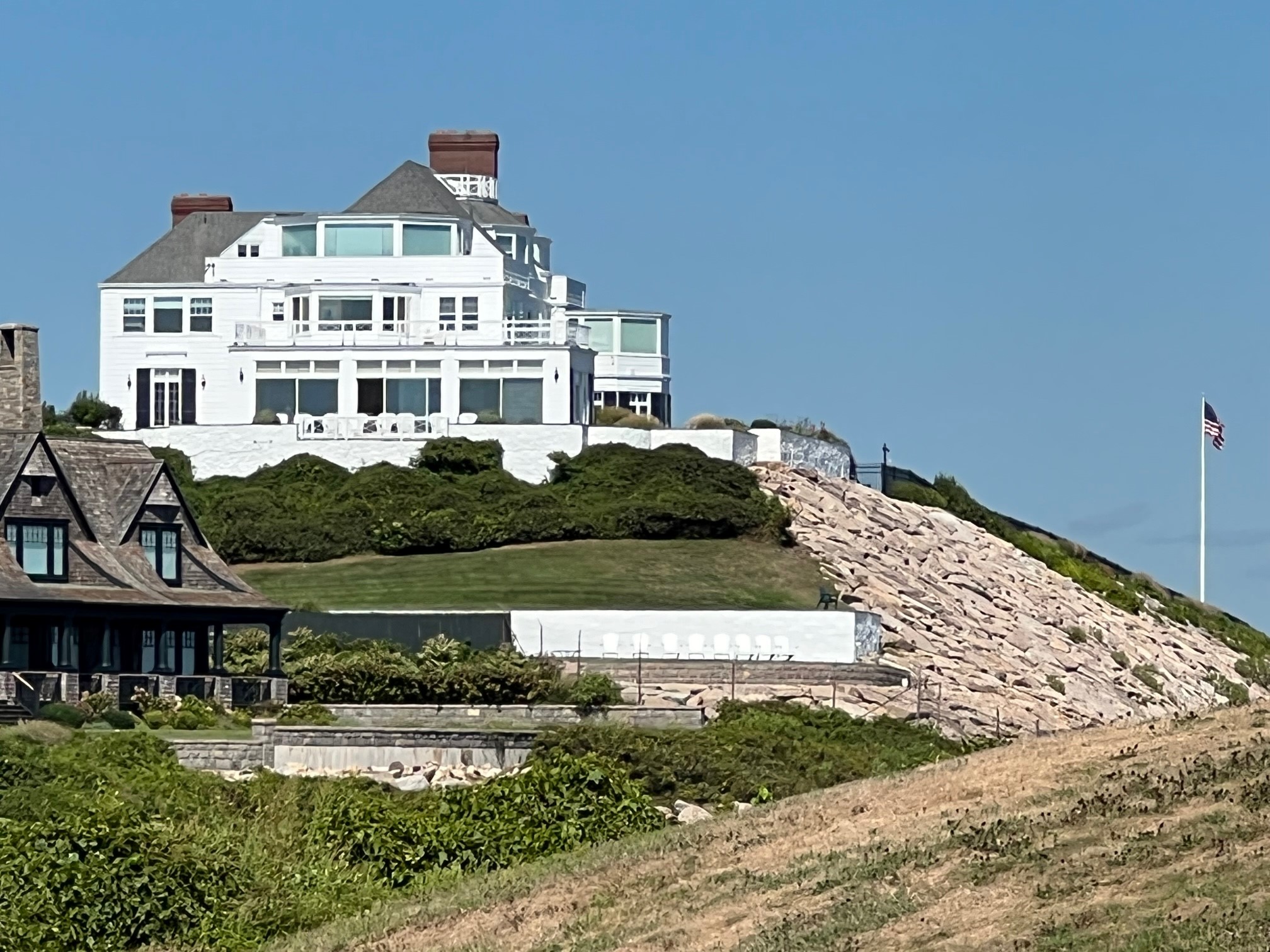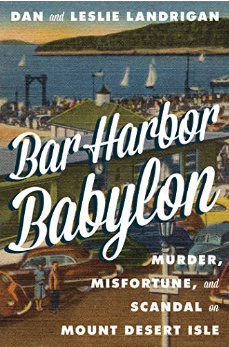[From the Publisher: This article originally appeared on the New England Historical Society’s website at newenglandhistoricalsociety.com. The New England Historical Society is similar to the Online Review of Rhode Island History, except that it covers all of New England (including Rhode Island). Dan and Leslie Landrigan do a terrific job publishing the website (and also authored the book Bar Harbor Babylon, Murder, Misfortune and Scandal on Mount Desert Isle, the cover of which appears on the right side of this page). We hope to share more of their articles with you in the future.]
Rebekah Harkness spent much of the Standard Oil fortune she inherited on the ballet. Not just going to performances, but sponsoring entire ballet companies, buying up real estate for them and sending them on world tours.
In 1962 she turned her Rhode Island estate, Holiday House, into a summer dance camp for the entire Joffrey Ballet company. She gave the dancers everything they needed and then some.
With her help, the Joffrey won international renown—something she wanted for herself. She danced, too, and composed music. But she annoyed the neighbors, alienated her children and provided a tempting target for critics. They called her ballets worthless, her music crap.
She thirsted for acclaim as a composer, a dancer and an arts patron, but her thirst for booze and pills undid her. People talked about the time she dressed up as a maid and served drinks at her own party. And about the times she cleaned her pool with Dom Perignon, dyed the neighbor’s cat green and filled her fish tank with scotch.
Fast forward 60 years, and another thin, rich, beautiful white woman bought Holiday House. And then in 2020, the house’s owner, Taylor Swift, wrote a song about Rebekah Harkness, called The Last Great American Dynasty. The music video featured the beach and the waves from the house, just as Rebekah Harkness would have seen it.
Rebekah Harkness
“She had a marvelous time ruining everything,” Swift crooned. Maybe. According to her biographer, Craig Unger, Rebekah Harkness led a life “littered with high Gothic tragedy.” She was a poor little rich girl, and by the end of her life, she was not that rich.
She was born April 17, 1915 to a wealthy St. Louis stockbroker Allen Tarwater West and his trophy wife Rebekah. West co-founded G.H. Walker & Co. with George Herbert Walker, grandfather and great-grandfather of the Bush presidents.
Her parents did care that she looked good, according to Unger. When they criticized her for getting pudgy, she took up skating and dance, practicing with a fierce discipline.
The family spent summers at Watch Hill, then an old money, old Hollywood enclave overlooking Block Island Sound. Clark Gable, Douglas Fairbanks and Andrew Mellon owned homes there.
Her parents packed Rebekah off to finishing school. She and her friends called themselves the Bitch Pack and disrupted debutante parties. They performed a strip tease at a social event and put mineral oil into the punch bowl at a coming-out party.
Franklin Pierce Descendant In-Law?
In 1939 she married Dickson Pierce because, she said, she did not have anything better to do. They had a son, Allen, and a daughter, Terry. Pierce claimed to be a descendant of President Franklin Pierce, though that would have been quite a feat. Franklin Pierce’s three children died before reaching adulthood.
The couple divorced in 1946. Then in 1947, she married Standard Oil heir William Hale Harkness, who brought her into the serious money class. The Harkness family had a reputation for its philanthropy. It donated Harkness Tower at Yale, Harkness Commons at Harvard and Harkness Pavilion at New York Hospital.
It was the second marriage for both of them. He had a daughter and a granddaughter who became the actress, Elizabeth Montgomery.
Rebekah and Bill Harkness had one daughter, Edith. It was the only successful marriage of her four, but it only lasted seven years. In 1957, Harkness keeled over at Holiday House while sitting for a sculpture Rebekah was working on, dead from a heart attack.
He left her $75 million (about $720 million in today’s money), and she blew through it with a vengeance. She spent a small fortune buying her way into the dance world, surrounding herself with dancers, musicians and choreographers. At the same time, she studied music composition and dance.
Rebekah also loaded up on art and real estate. She bought a mansion in Palisades, N.Y., a Manhattan penthouse and getaways in Nassau and Gstaad. She also expanded Holiday House to include eight kitchens, 42 rooms and 21 baths. Nine servants and three cooks kept the place running.
“This arrangement effectively kept her from having to see her three children on anything like a regular basis,” The New York Times commented.
Holiday House
While Bill Harkness was alive, he and Rebekah threw raucous parties every weekend. She once dressed as a waitress at one of them so she could eavesdrop on the guests. But the loud parties caused problems with the neighbors. So did the ballet dancers practicing on her lawn. When she erected a giant blue geodesic dome on her lawn, they sued her for zoning violations. She retaliated by dying a neighbor’s cat green.

Ballet dancers performing “Sleeping Beauty” for the Stuggart Ballet on June 7, 1977 (Library of Congress)
The parties continued when she brought the entire Joffrey to Watch Hill in 1962 and 1963. Then a little-known ballet company, they spent the summers practicing and experimenting with new ideas. She gave them weekends off and charge accounts to the shops in town. She once served them a cake with $10 bills baked into it. If a dancer needed dental work or a nose job, she paid for it. And when she discovered one of her Joffrey dancers did not own a suit, she sent all the Joffrey men to Saks and all the women to Bergdorf’s for formalwear.
She also bought them an old firehouse in Westerly to practice in, calling it the Harkness Center for the Arts.
Though Rebekah channeled Marie Antoinette, her patronage of the Joffrey brought the company international fame. She also helped discover and train many acclaimed dancers, regardless of their race, background or body shape.
The Joffrey dancers who spent the summer at Holiday House loved it. “We were in heaven,” said Danish ballerina Lone Isaksen.
Her children, not so much. They complained she cared more about the dancers than she cared about them.
Price to Pay
The Joffrey had a price to pay for Rebekah Harkness’s support. She insisted that it perform ballets to scores she had written. One work, Dreams of Glory, had an insipid story about a little boy who dreams of becoming John F. Kennedy. Dancer Lawrence Rhodes said it was one of the few times he was embarrassed to be in a ballet.
Others—Jerome Robbins and George Balanchine — flatly refused to choreograph her musical compositions. The same fate befell the popular tunes she composed.

Watch Hill, with a westward view, overlooking Watch Hill Harbor and the beach at Napatree Point, circa 1910 (Providence Public Library Digital Collections)
When Harkness offered to pay Ella Fitzgerald to sing some of her pop songs, Fitzgerald would not do it.
Rebekah Harkness’s Ballet
After two years, Rebekah Harkness suddenly cut her ties to the Joffrey when Robert Joffrey, its founder and choreographer, would not rename his company for her. Then she stole most of the Joffrey dancers for her own ballet company – the Harkness.
She started by bringing the company to Watch Hill (despite the neighbors) in the summer for instruction, practice and choreography. The Harkness Ballet would eventually have two touring companies, a youth ballet (which taught Patrick Swayze) and its own theater. In its day, the Harkness would train more professional dancers than any other company.
Rebekah bought a mansion on New York’s Upper East Side and turned it into a posh training center for dancers called Harkness House. She brought in top choreographers, Jerome Robbins and Brian Macdonald — to teach 16- and 17-year-olds. She hired Salvador Dali to design sets. And she gave Alvin Ailey his first commission.

The Ocean House Hotel, with a path leading to East Beach in Watch Hill, circa 1930. Holiday House would have been just to the right of this scene. Then called High Watch, it was built in 1929-1930, possibly after this photo was taken. When built, it was much larger than it is today (Providence Public Library Digital Collections)
In 1972, she bought an old theater near Lincoln Center and refurbished it on a grand scale as the first theater devoted exclusively to ballet. It had hand-carved Louis XIV chairs and a huge mural that featured the company’s dancers – as well as Rebekah Harkness – in the nude. One critic denounced it as the worst mural ever made.
Critics
The critics, especially The New York Times’s Clive Barnes, savaged Rebekah. The rich socialite whose judgment sometimes lapsed was just too good a target. She did not help herself with her capriciousness. She got thrown off a cruise for swimming nude in the pool and swearing at the crew. Once she pretended to be a cleaning woman and approached the reclusive J.D. Salinger, hoping to convince him his stories should be set to her music.
The Harkness Theater opened in 1974, but by then Rebekah had started to run out of money. She began to cut back and look for public funding. She ended up selling the theater at a huge loss, and the Harkness Ballet company folded in 1975. Today it’s pretty much forgotten, despite the tens of millions of dollars she spent on it.
But according to the book An American Ballet Story,
[T]he dancers, choreographers, composers and designers were pioneers and experimenters. Themes of sexual repression, homoerotic love, tribalism and even the aftermath of rape were explored by some of the most famous choreographers of the time. All of the work and much of the music was original.
The Sad End
Rebekah struggled with drugs and alcohol. She developed an addiction to injections of B-vitamins, painkillers and testosterone. Guests would find needles in her bathrooms, their walls spattered with blood. Her voice grew husky and her muscles calcified.
She’d had a brief, unhappy marriage to a doctor in the early 1960s. In 1971, she married a fourth time, to another doctor, but one 20 years her junior. That marriage lasted three years.
Meanwhile, the booze and the pills caught up with her. So, in 1977 she checked into Silver Hill, a rehab clinic in New Canaan, Conn. When she got out, she sold her Palisades mansion to the Isley Brothers.
In November of 1977, her son Allen shot a man during a brawl in Miami. He received a prison sentence of 15 years but did not bother to get in touch with his mother. He later said his time in prison was the happiest of his life.
Her youngest daughter, Edith, had tried to commit suicide at the age of fifteen by flinging herself out of a high rise in front of her. An awning saved her life. Edith spent her life in and out of mental institutions, finally committing suicide in 1982. Rebekah died that same year after a long bout with cancer. She died June 17, 1982 at the age of 67.
The Holiday House property was divided into three lots, according to Watch Hill Through Time. The gargantuan house itself was partially demolished, then sold to a family that remodeled it and renamed it High Watch.
Taylor Swift bought the former Holiday House in 2013 for a reported $17.75 million in cash. She brought her Squad – musician, actor and model friends – to the mansion for Fourth of July ‘Taymerica’ parties. They featured fireworks, boat rides and a giant inflatable water slide. Swift gave all her friends matching red-white-and-blue onesies.
The celebrities brought paparazzi and, echoes of the Rebekah Harkness era, complaints from the neighbors. Swift put up “No Trespassing” signs that they did not like either. Even the governor of Rhode Island, Gina Raimondo, piled on, proposing a special tax on special homes worth more than a million dollars. People called it the “Taylor Swift Tax,” though it never became law.
When Swift bought the house, a local writer for The Day reminded her of the time a body washed up on the beach under her Watch Hill mansion.

Holiday House in August 2022, now owned by talented singer-songwriter Taylor Swift (Christian McBurney)
During the 2020 COVID-19 pandemic, Swift wrote and recorded a new album called Folklore. One song, The Last Great American Dynasty, is about Rebekah Harkness. Swift Identifies with Harkness in her last line, “There goes the loudest woman this town has ever seen/ I had a marvelous time ruining everything.” Here is a link to a YouTube video showing the song.
The music video that accompanies the song features the beach below Holiday House as Rebekah Harkness would have seen it. (Watch it here.)
https://www.youtube.com/watch?v=2s5xdY6MCeI&list=RD2s5xdY6MCeI&start_radio=1
Main Sources:
Sasha Anawalt, The Joffrey Ballet: Robert Joffrey and the Making of an American Dance Company (New York: Scribner, 1996).
Craig Unger, Blue Blood, The Story of Rebekah Harkness and How One of the Richest Families in the World Descended into Drugs, Madness, Suicide, and Violence (New York: William Morrow & Co., 1988).
The link to the article on the New England Historical Society’s website, which has more links embedded in the article and photos, is here: https://newenglandhistoricalsociety.com/rebekah-harkness-the-scorned-socialite-of-watch-hill-r-i/


























